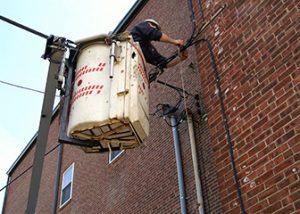Energy Efficiency Jobs
Electrical power-line installers and repairers are critical to making sure green energy gets to your home.
Electrical power-line installers and repairers are critical to making sure green energy gets to your home.
Electrical power-line installers and repairers focus on installing, maintaining or repairing electrical distribution and transmission systems. These systems include conduits, cables, wires, and equipment such as transformers, circuit breakers, and switches. Electrical power-line installers and repairers typically need to drive vehicles equipped with their tools and materials to job sites. At the job sites, they may climb poles or transmission towers or use truck-mounted buckets to access equipment. These green job holders often have to remove electrical hazards from distressed or fallen lines and open switches or attach grounding devices to facilitate repairs.
 By utilizing wiring diagrams and electrical-testing instruments, electrical power-line installers and repairers identify defective devices, circuit breakers, fuses, voltage regulators, transformers, switches, relays, or wiring. Electrical power-line installers and repairers operate power equipment when installing and repairing poles, towers, and lines. They will also string wire conductors and cables between poles, towers, trenches, pylons, and buildings allowing green energy to flow from place to place. They will often use winches to adjust tension while setting electrical lines in place. Electrical power-line installers and repairers use the following tools in their job:
By utilizing wiring diagrams and electrical-testing instruments, electrical power-line installers and repairers identify defective devices, circuit breakers, fuses, voltage regulators, transformers, switches, relays, or wiring. Electrical power-line installers and repairers operate power equipment when installing and repairing poles, towers, and lines. They will also string wire conductors and cables between poles, towers, trenches, pylons, and buildings allowing green energy to flow from place to place. They will often use winches to adjust tension while setting electrical lines in place. Electrical power-line installers and repairers use the following tools in their job:
As part of their job, electrical power-line installers and repairers adhere to safety practices and procedures by checking equipment regularly and putting up barriers around work areas. They also lay insulating or fireproofing materials over conductors and joints to ensure safety.
Electrical power-line installers and repairer jobs are physically demanding. They must be comfortable working at great heights and in confined spaces. They also must be able to climb utility poles and transmission towers and balance while working on them. They are frequently required to drive utility vehicles and travel long distances. They usually must work outdoors and under poor weather conditions, including in snow, storm, wind, rain or extreme heat and cold to repair lines to ensure the delivery of electricity to customers.
Most electrical power-line installers and repairers enter this green career with a high school diploma or equivalent. They are usually required to have basic knowledge of algebra and trigonometry and appropriate reading skills. Technical knowledge of electricity or electronics obtained through military service, vocational programs, or community colleges is also helpful in this job. Many community colleges offer programs in electronics or electricity. Some programs work with local companies to offer 1-year certificates that emphasize hands-on field work. Most community colleges offer a 2-year associate’s degree programs that provide students with a broad knowledge of the technology used in electrical utilities.
Electrical line installers and repairers often must complete formal apprenticeships or other employer training programs. There are 6 recognized apprenticeable specialties associated with this occupation: Cable Installer-Repairer, Cable Splicer, Line Erector, Line Maintainer, Line Repairer and Trouble Shooter II. These programs can last up to 5 years including both on-the-job training and technical instructions. Apprentice electrical line installers are required to have safety regulation education, but licensure is not required. The National Joint Apprenticeship and Training Committee also offers certification for electrical line installers in several specialty areas.
The Bureau of Labor Statistics (BLS) expects employment of this field to grow 13 percent from 2010 until 2020; this is among the average speed for all green jobs. The BLS projected 52,700 electrical power-line installers and repairers job openings between 2010 and 2020, and noted 108,000 jobs are currently filled. Titles included Lineman, Journeyman Lineman, Electrical Lineworker, and Power Lineman. The BLS further reports that the median annual wage for salaried electrical power-line installers and repairers was $60,190 in 2011 with median hourly wage of $28.94. The lowest 10 percent earned less than $33,680, and the top 10 percent earned more than $82,450.